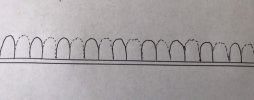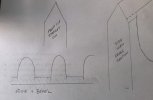Modernflame
Gold Member
- Joined
- Jun 12, 2021
- Messages
- 1,202
I didn't see it at first, either, but if you enlarge the second image it says HRC 55+/- 2What do you see in the picture that reveals the hardness of the blade?
The BladeForums.com 2024 Traditional Knife is ready to order! See this thread for details:
https://www.bladeforums.com/threads/bladeforums-2024-traditional-knife.2003187/
Price is $300 $250 ea (shipped within CONUS). If you live outside the US, I will contact you after your order for extra shipping charges.
Order here: https://www.bladeforums.com/help/2024-traditional/ - Order as many as you like, we have plenty.
I didn't see it at first, either, but if you enlarge the second image it says HRC 55+/- 2What do you see in the picture that reveals the hardness of the blade?
Oh Lord, you've got better eyes than I do.Second picture. Blade is etched with the info.
-Mark
To your first point. IMHO the proper way to maintain a flat ground knife is to lay it flat on the stone and take a few strokes at each sharpening. This way the blade is thinned little each time and reprofiling is never necessary. Most knives are over thick from the start (You will be shocked at how imperfect most knives are out of the box.) One word of caution this method sometimes produces very sharp spines so be sure to knock the sharp corners down.The real issue is that as you sharpen higher up towards the spine, the edge becomes more and more obtuse as the blade becomes thicker the more you grind away. You will lose a lot of slicing capability unless you re-profile the secondary cutting edge to a thinner (more acute) bevel to account for this.
Obviously if you sharpen into the divot area, you will end up with a "serrated" kind of edge, and the grind will not be even/flat. This may or may not impact performance, depending upon what you are
To your second point. I was told years ago that the divots or grantons are supposed to be alternating front to back and that even at their thinnest point they are thicker than the edge bevel so you never really get a serated edge.

I remember dozens of such knivesI remember a butcher knife we had when I was a kid that resembled a fillet knife after decades of resharpening.
shane45-1911 Yes the side will be wavy the edge will be straight it won’t be at all like a serated edgeView attachment 1676326
My understanding if they are done correctly when sharpened down it would look like this. The dotted grantons are the ones on the other side. Even at their thinnest they are thicker than the edge bevel. Also if you are thinning the blade at each sharpening the grantons will be smaller
The edge and the bevel will be straight, even from straight on. The grantons shouldn’t go deep enough to effect the edge or the bevel. .
The grantons will still be there doing their job (whatever it is) but they won’t effect the edge.
Again this is assuming the grantons were ground and placed correctly in the first place.

I can’t see your picture

Point being the grantons are shallow enough that you can sharpen into them and have a straight edge.
They aren’t deep enough to effect the edge bevel.

Your side view is correct for a seration which is much deeper than a granton should be.Of course they are! The only way they wouldn't affect the edge bevel is if you ground down the entire blade on both sides to remove any trace of them.
Think of a Spyderco knife (or any other serrated blade). If you were to sharpen it on a flat stone, you will eventually make the edge flat when viewed from the side, but if you viewed the edge from above looking straight down on it, all the scallops will still be there.
You can't just make divots go away like that. They will still be there. I have corrected your side view cross section pic:

